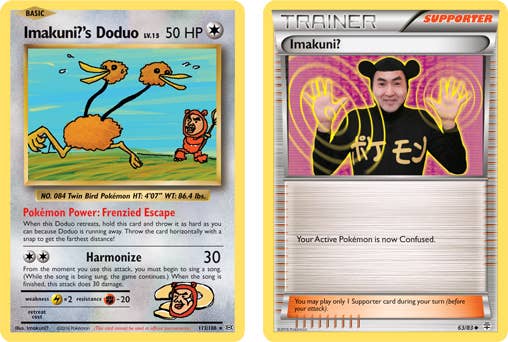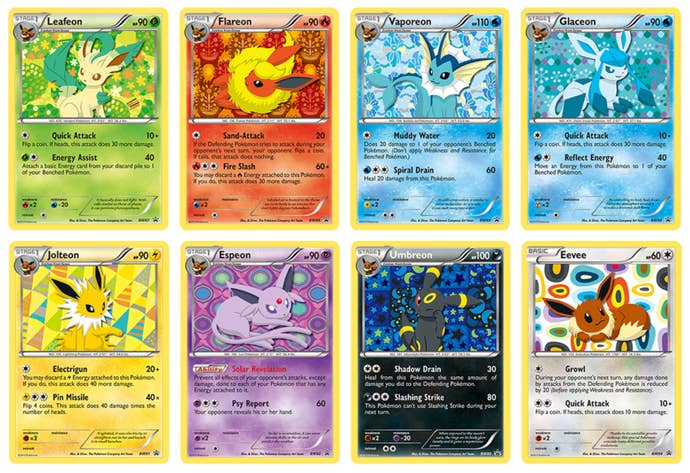How The Pokemon Trading Card Game Helped Define the Art and Identity of Pokemon
Gotta collect 'em all.
This article first appeared on USgamer, a partner publication of VG247. Some content, such as this article, has been migrated to VG247 for posterity after USgamer's closure - but it has not been edited or further vetted by the VG247 team.
Pokemon was everywhere when I was a kid. Like everywhere. On backpacks. On shirts. On Game Boys—whether bedazzled with stickers or on the screen itself. On Halloween costumes. You could not escape the likes of Pikachu, Squirtle, Charmander, and Bulbasaur, no matter how hard you tried. Everyone was vowing to be the very best, like no one ever was.
But my first experience with Pokemon wasn't through the hit games Pokemon Red or Blue; in fact, it wasn't through a video game at all. It was through the Pokemon Trading Card Game, those flimsy cardstocks you could buy in packs. Before Mitt Romney boasted about having "binders full of women," kids everywhere had binders full of energy cards for no particular reason.

The Pokemon Trading Card Game began in earnest in North America in early 1999, in the heart of Pokemania. It was published by Wizards of the Coast before The Pokemon Company took over in 2003, translating the cards developed by Media Factory for an English-reading audience. In Japan, the Pokemon Trading Card Game had premiered years prior in 1996. It was popular in Japan, but it exploded when it came to the United States.
I didn't get a Game Boy until the Game Boy Color, which was my first Nintendo-anything along with Pokemon Gold. But by the the time I embarked on my journey through Johto with a Chikorita at my side, I was well familiar with the likes of Pokemon. Partly because it was inescapable, but largely because I already had a ridiculous amount of Pokemon Trading Cards stowed away.
Even with the original card series, the art has always been the central draw for me. I never strategized with building decks. I never cared about collecting cards for sheer power—only cute art. (Though, once I did get duped out of my rare Ancient Mew card from the second Pokemon movie opening for a bunch of energy cards, because I was a dumb kid who was bullied by kids on the playground and they convinced me it was a fair trade. It wasn't, of course.) I didn't master the card battling and card traits like older kids did. I just collected them because I liked the art and would pin them on a corkboard I had. It was also, arguably, really the only Pokemon art we had access to back then besides the watching the anime.
"As you know, the first Pokemon video games came out on the Game Boy in monochrome, with a really rudimentary pixel art,” illustrator Mitsuhiro Arita, who has been drawing Pokemon cards for over 20 years, said in an interview on Pokemon's official blog. “So when I started on this project, pretty much all I had as reference were those sprites—the pixel art of the Pokemon." The blog goes on to state that Arita (along with other early illustrators on TCG), essentially helped define the artistic identity of Pokemon. And I believe they helped evolve it beyond that original framing too.
I remember the art on those early cards clearly, as I imagine many people my age do. There was a rough quality to them, something that made it obvious that it was more than a single artist sketching interpretations of the Pokemon. It made the cards all feel individual, knowing that they didn't all seemingly go by the strict guidelines of the games' pixel art and covers. For example, in Akira Komayama's work, Pokemon are shown typically relaxing in their natural environments rather than in the midst of an attack. In a particular Eeveelution series by The Pokemon Company, the likes of Leafeon, Vaporeon, and more are placed on a patterned background that matches their color palette.
The great thing about Pokemon's trading cards is that each feels singular, and not just because of its attributes. While that's by no means a unique trait of trading card games, for Pokemon, it feels so. The RPGs often feel so static, that the only way that Pokemon had the chance to play with its identity and style in the early goings was through the official Trading Card Game.

The Pokemon Trading Card Game is still thriving to this day. It's even controversially cost prohibitive for some, but that hasn't quite hurt its bustling competitive scene. While The Pokemon Trading Card Game was an exciting way to pass the time at recess back in the day, nowadays it's almost reserved for the serious fans only; the ones who care more about sizing up their decks than if a card features art by famed Pokemon art director by Ken Sugimori.
In recent years, Creatures Inc. in Japan has been handling the current state of the Pokemon Trading Card Game. In an interview with GameSpot, director Atsuhi Nagashima spoke of its design philosophy. "We really try to take care to stay true to the video games that we're basing the card series on," Nagashima told the site. "For example, the Pokemon that were featured heavily in that video game or had a big role in the story, we'll make sure they're kind of at the center of the set we're making. But once we're kind of mid-way through the series, we start focusing more on play environment overall…and decide which Pokemon to put in based on that."
Pokemon's definitely on the up and up again, thanks to the success of Pokemon Go and the series' upcoming debut on Nintendo Switch. Of course, it never really went away in the first place. Kids and adults alike have always vowed to catch 'em all, no matter its platform. I imagine with Pokemon's renewed dominating presence that eventually we'll hear about a re-release or refresh of the 2011 Pokemon Trading Card Online game, a digital online card game that'll maybe feel more modern now that it'd be competing with the likes of Hearthstone, Magic: the Gathering, Artifact, Gwent, and whatever else. I can see Pokemon's very specific twist on trading cards do well online—if it realigns its approach to the digital collectible card realm right.

In the meantime, we'll always have the Pokemon Trading Card Game. There's even a surprisingly thorough official database of every card, where you can browse by name, artist, and so on. Some modern cards have even done away with the traditional card format, with the Pokemon taking up the entire card. (Personally, I'm into the classic design more.) The Pokemon Trading Card Game is evolving with the times, and I imagine special decks and cards and art will continue well into the future.
It's not slowing down either. As of March 2018, over 25.7 billion cards have been shipped worldwide, according to The Pokemon Company. Cards are in 11 languages to date, and are sold in 74 countries overall. It may not seem like Pokemon's trading card side-ops are as loud and prominent as they once were across playgrounds, but the truth is, they're still everywhere. They're still in the aisle where you buy your kids toys for holidays. Pokemon trading cards never went away, they only reached new audiences and got more cards.
Nowadays, we see the Pokemon Trading Card Game's influence everywhere. In merchandise, Pokemon are frequently twirled into new art styles, fit into new settings, and made cuter and more interesting than their origins. We see it in its spinoff games too, like Detective Pikachu, which usher Pokemon into new roles and new game styles. It might be a stretch to insinuate that the trading cards had anything to do with that, but realistically, it was the first of the Pokemon name to branch out in earnest and try new things. Without it, we never would have gotten quirky cards like the famed "Imakuni?" card.
It's daunting to realize that there are so many cards out there that I have never seen before. My fondest time will always be as that dopey kid at recess though, thumbing through my cards as kids with rich parents played the proper game on Game Boys. The trading cards helped me not be the odd kid out in discussing the new hot trend, and for that, I'll always be grateful.

